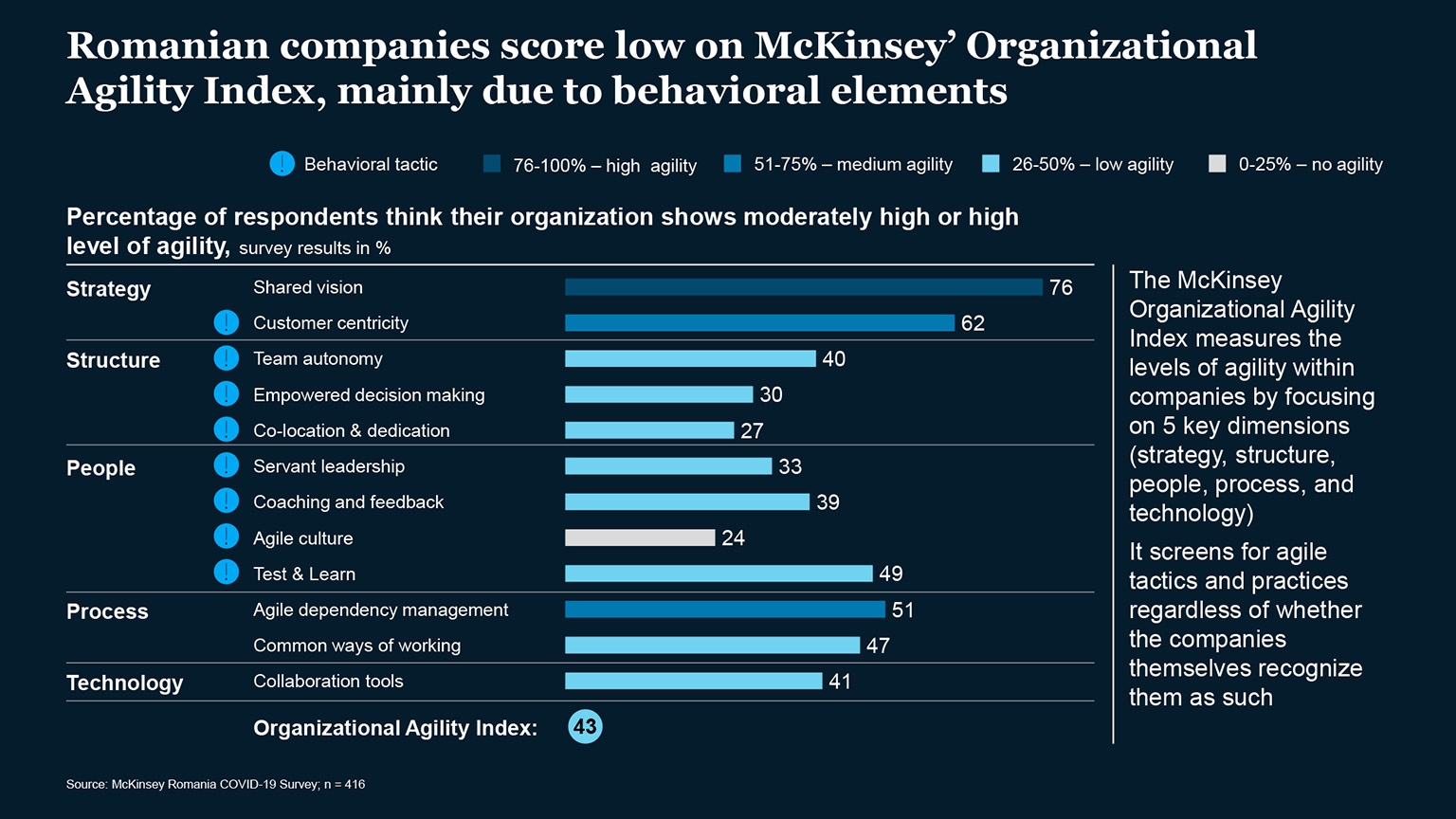Nearly all Romanian companies have made organizational changes to address COVID-19-related hardship, according to a recent study of 416 of companies with more than 250 employees, from a diverse mix of industries. Among the changes that 97 percent of companies made, remote work is considered the most helpful by the majority of employees and is also expected to remain in place as a standard practice in the medium term. While operating models vary across industries, 56 percent of the organizations have adopted either hybrid or remote working models.
Agility is proving to be a useful attribute for many global organizations weathering the COVID-19 crisis. Faced with business disruptions, staff lockdowns, and high degrees of uncertainty, nearly every organization, agile or not, has had to pull out new crisis management playbooks. The pandemic has demonstrated the need for all organizations to be able to face unforeseen disruption in an agile way, by combining speed with stability, innovation, and operational discipline. While enterprise agility was an option before, it is now becoming essential, according to recent research conducted by McKinsey and the Harvard Business School that was published in a report entitled, “How well did agile organizations respond to the COVID-19 shock?”
As part of this research we reviewed publicly available data for more than 50 organizations across the globe and found that in the face of COVID-19, agile organizations had an important edge: they were twice as fast, more adaptable, and managed employee morale better. Interviews completed by McKinsey with 25 organizations worldwide that have gone through agile transformations also consistently highlighted that they were better prepared to handle the COVID-19 challenge.
The research also highlights that many structural elements of agile organizations, such as agile ceremonies and cross-functional teams, helped considerably during the initial stage of remote working; at the same time, behavioral elements, such as empowerment and servant leadership, and outcomes-based performance tracking, goals, and resource reprioritization, have gained significant importance for employees as the next normal has settled in. The adjustment to the crisis has brought new challenges concentrated along the elements of motivation and collaboration, with almost six of ten respondents in Romania considering these areas to be the biggest internal pain points during the lockdown.
When assessing the agility of Romanian companies through the lenses of our Organizational Agility Index across the dimensions of strategy, structure, people, processes and technology, the overall score is relatively low, 4.3 out of 10.0, with multiple gaps identified over several dimensions, but concentrated around the behavioral elements (such as team autonomy, empowered decision making, servant leadership, coaching, and feedback). All in all, a shared vision and a customer centricity approach show medium to high agility across the board, but the people and the structural elements behind them score significantly lower levels of agility. Looking across industries, there is discrepancy in agility levels, with IT and financial services being the front-runners, with overall scores being up to 9 percentage points higher than other industries.

Additionally, managers across all the industries tend to overestimate their company’s level of organizational agility by as much as 25 percent, meaning that some gaps are less evident to them as opposed to non-managerial positions. The biggest gaps identified are in the areas of “servant leadership,” “test and learn,” and “agile dependency management.” Similarly, the elements of “team autonomy” and “decision making” are seen as less agile by female respondents while “co-location and dedication” is seen as the main agility pain point by older employers (ages 40 and up).
Agile is not a solution only for navigating an acute crisis like the current pandemic, but rather one for navigating any fast-changing, competitive environment. Organizations that want to keep the benefits they have observed during the COVID-19 crisis, such as faster decision making and clarity of purpose, need to make that choice now. To shift toward an agile operating model, they need to reflect on what they have learned during the crisis and be deliberate about which practices to keep.
This also requires a comprehensive cultural transformation, which is more difficult than ever, as employees are working remotely. Executives should seek long-term cultural changes, starting with basic tactics, and focusing on substantial behavioral changes.